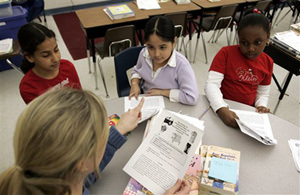The Rebirth of Education
A friend of mine, J.M. Zimmerman, once stated that to revitalize our schools, engage our children and ultimately save our planet will require “the death of education and its rebirth.” Sometimes systems are so flawed that they need to be scrapped and replaced rather than fiddled with or fixed.
A friend of mine, J.M. Zimmerman, once stated that to revitalize our schools, engage our children and ultimately save our planet will require “the death of education and its rebirth.” Sometimes systems are so flawed that they need to be scrapped and replaced rather than fiddled with or fixed.
Not all — but many — American schools and systems fall into this category. They are not just damaged; they are truly broken. All across the country we find fledgling examples of rebirth where children are truly learning and are excited about the process. We find schools that have dared to take risks and acknowledge that 50 percent-plus dropout rates are clues that something is seriously and tragically amiss. However, a quality program here and a successful school there are not enough. Millions of children are being left behind and millions more leave high school with limited skills, the result of dumbed-down curricula and meager value systems reflecting a consumer culture in which scores on standardized tests are the ultimate, and often the only, measure of a successful education.
Study after study indicates, or even forcefully proclaims, that America’s schools are failing to educate. Comparative studies show American schools are way behind other countries on a variety of scales, yet what we get from the federal level are underfunded demands that our schools measure up to high-stakes tests, and we get inner-city and poor rural schools desperately trying to deal with nearly impossible surroundings and internal conditions with anemic budgets. One can only hope at this point that the Obama administration will provide dramatic leadership. President Obama did say, on the campaign trail, that he wants to create 20 new “Harlem Zones.” This would be one such dramatic step.
What is needed are bold new visions and a commitment to find such visions. Some of these visions are already in place, and they can serve as models of systemic and comprehensive change. New York, for example, has developed a whole menu of “new visions” schools which value small learning communities, site-based autonomy and imaginative curricula freed up from crushing bureaucracy. Also in New York, Geoffrey Canada pioneered the Harlem Children’s Zone, based on the premise that to improve schools one needs to improve the surrounding neighborhood through social services aimed at the entire family. And across the country, Dennis Littky and Elliot Washor have created the “Big Picture” schools that combine real-life experiences, internships and apprenticeships based on students’ interest with academic studies that grow out of the students’ experiences. Their academic and college enrollment successes — with high-risk students — have been extraordinary.
All the reform efforts that I have seen or researched have several ingredients in common: First, they regard each student as an individual project and attempt to build upon student interests; consequently, the teachers and administrators know the students by name and by personality; the curricula are wide and diverse so that each student can discover his or her passion and can follow that passion; test scores are accorded their proper role as occasional check-ins rather than life-stifling determinants; community involvement, activism and service are central concerns, as are the arts, human development, environmental studies and outdoor experiences; and finally, the creation of a humanistic, encouraging, friendly culture is at the core of the schools’ very being — students are respected, nurtured, listened to, and challenged but supported, and respect for diversity is insisted upon. Of course, and contrary to what some experts opine, class size does matter and a small class size carries major funding implications.
When these ingredients are valued and are at the center of the school’s philosophy, then students invariably buy in and actually enjoy school. It can happen. I have seen it happen. If we are to prevent more angry, alienated, ill-educated dropouts from bringing themselves and their communities down, then we need to have the courage to take risks and return to what is essential. We also need to fund these reform efforts.
Your support matters…Independent journalism is under threat and overshadowed by heavily funded mainstream media.
You can help level the playing field. Become a member.
Your tax-deductible contribution keeps us digging beneath the headlines to give you thought-provoking, investigative reporting and analysis that unearths what's really happening- without compromise.
Give today to support our courageous, independent journalists.









You need to be a supporter to comment.
There are currently no responses to this article.
Be the first to respond.